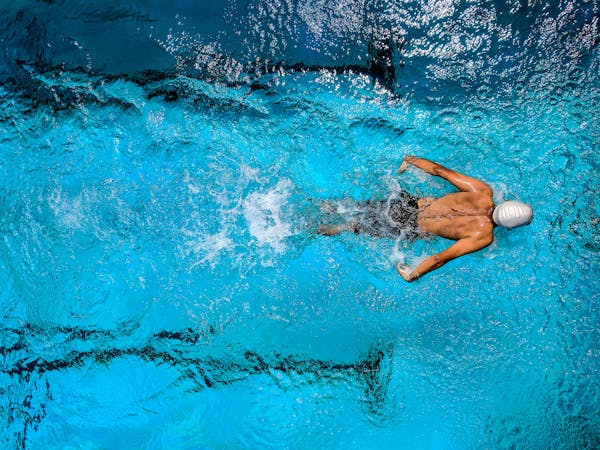Introduction:
Swimming is often regarded as one of the most effective and
enjoyable forms of exercise. Beyond its recreational appeal, swimming offers a
comprehensive workout that engages multiple muscle groups, improves
cardiovascular health, and enhances overall fitness. Whether you're a beginner dipping
your toes into the water or a seasoned swimmer looking to maximize your fitness
gains, understanding how to build fitness with swimming can help you achieve
your goals effectively. In this blog, we explore the benefits of swimming,
various swimming techniques, training tips, and ways to integrate swimming into
a balanced fitness regimen.
The Benefits of Swimming
Swimming provides numerous physical and mental health
benefits that contribute to overall wellbeing:
1. FullBody Workout: Swimming engages muscles throughout the
body, including the core, arms, legs, back, and shoulders. It promotes
strength, endurance, and muscle tone.
2. Cardiovascular Conditioning: Swimming increases heart
rate and improves cardiovascular fitness without placing stress on the joints,
making it ideal for individuals with joint pain or mobility issues.
3. Improved Flexibility and Range of Motion: The fluid
movements involved in swimming promote flexibility and joint mobility, reducing
the risk of injury and enhancing overall agility.
4. Calorie Burning: Depending on intensity and stroke
technique, swimming can burn a significant number of calories. It supports
weight management and contributes to a healthy metabolism.
5. LowImpact Exercise: The buoyancy of water reduces impact
on the joints, making swimming suitable for people of all ages and fitness
levels, including those recovering from injury.
6. Mental Health Benefits: Swimming is known to reduce
stress, promote relaxation, and improve mood by releasing endorphins, the
body's natural feelgood chemicals.
Swimming Techniques for Fitness
To maximize fitness gains from swimming, mastering proper
techniques and strokes is essential. Here are some of the most common swimming
strokes and their benefits:
1. Freestyle (Front Crawl):
Technique: Freestyle involves alternating arm
strokes and flutter kicks while maintaining a streamlined body position.
Benefits: It is efficient for covering long
distances, improves upper body strength, and enhances cardiovascular endurance.
2. Backstroke:
Technique: Swimmers float on their backs and
perform alternating arm strokes with a flutter kick.
Benefits: Backstroke strengthens back muscles,
improves posture, and provides a balanced workout to complement freestyle.
3. Breaststroke:
Technique: Swimmers perform simultaneous arm
movements (resembling a frog kick) with a glide and kick motion.
Benefits: Breaststroke targets chest, arms,
and leg muscles, enhances flexibility, and is suitable for beginners due to its
slower pace.
4. Butterfly Stroke:
Technique: Butterfly involves a simultaneous
dolphin kick with an overhand stroke, requiring coordination and power.
Benefits: It builds upper body strength, core
stability, and improves cardiovascular fitness through its demanding nature.
Training Tips for Building Fitness
To effectively build fitness through swimming, consider
incorporating these training tips into your routine:
1. WarmUp and Cool Down: Begin each session with a gentle
warmup, such as easy laps or dynamic stretches, to prepare your muscles and
joints. End with a cooldown to gradually lower heart rate and prevent muscle
soreness.
2. Interval Training: Alternate between periods of highintensity
swimming (e.g., sprinting) and lowintensity recovery laps to improve
cardiovascular endurance and burn calories more efficiently.
3. Distance and Endurance: Gradually increase the distance
or duration of your swim sessions to build endurance over time. Focus on
maintaining a steady pace and proper technique throughout.
4. Strength Training: Incorporate resistance training
exercises, such as using swim paddles, pull buoys, or resistance bands, to
enhance muscular strength and power in the water.
5. Technique Refinement: Work with a swim coach or
instructor to refine your stroke technique, breathing patterns, and efficiency
in the water. Improved technique not only enhances performance but also reduces
the risk of injury.
6. CrossTraining: Supplement swimming with other forms of
exercise, such as strength training, yoga, or cycling, to maintain overall
fitness and prevent overuse injuries.
7. Set Realistic Goals: Establish specific, measurable
goals, such as swimming a certain distance within a set time frame or mastering
a new stroke technique. Tracking progress can help maintain motivation and
monitor improvements.
Integrating Swimming into a Fitness Regimen
To reap the full benefits of swimming for fitness, consider
integrating it into a wellrounded fitness regimen that includes:
1. Strength Training: Incorporate resistance exercises to
target muscles not fully engaged during swimming, such as squats, lunges, and
core exercises.
2. Flexibility and Mobility: Supplement swimming with yoga
or stretching routines to improve flexibility, balance, and joint mobility.
3. Cardiovascular Exercise: Include activities like running,
cycling, or aerobic classes to complement swimming and enhance overall
cardiovascular health.
4. Rest and Recovery: Allow adequate rest days between swim
sessions to prevent overtraining and promote muscle recovery. Listen to your
body and adjust your training intensity accordingly.
Overcoming Challenges in Swimming
While swimming offers numerous benefits, it may present
challenges that can affect your fitness journey:
Breathing Technique:
Proper breathing technique is crucial for efficient swimming. Practice rhythmic
breathing and bilateral breathing (alternating sides) to improve endurance and
oxygen intake.
Water Confidence:
Overcoming fear or discomfort in the water may require gradual exposure and
practice in a safe, supportive environment.
Time Constraints:
Balancing swim sessions with work, family, and other commitments may require
careful scheduling and prioritization.
Technique Mastery:
Achieving proficiency in different strokes and techniques may take time and
patience. Seek guidance from experienced swimmers or coaches to enhance skills
and confidence.
Conclusion
Swimming offers a versatile and effective means of building
fitness, enhancing cardiovascular health, and improving overall wellbeing.
Whether you're seeking to increase strength, improve endurance, or simply enjoy
a lowimpact workout, incorporating swimming into your fitness regimen can yield
significant physical and mental benefits. By mastering proper stroke
techniques, incorporating training strategies like interval training and
strength exercises, and integrating swimming into a balanced fitness routine,
you can maximize your fitness gains and achieve your personal health goals.
Remember to approach swimming with enthusiasm, persistence, and a focus on
gradual improvement, allowing you to enjoy the lifelong benefits of this
rewarding exercise form.


.jpeg)
.jpeg)
